PROTECT YOUR DNA WITH QUANTUM TECHNOLOGY
Orgo-Life the new way to the future Advertising by Adpathway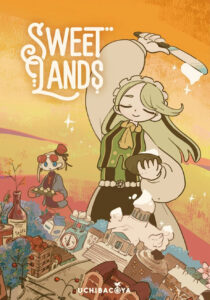 People sometimes mistake me for a health-conscious person when I turn down Krispy-Kreme donuts or hard candies. What they don’t understand is that I am such an extreme chocoholic that, with few exceptions, I think desserts just aren’t worth the calories if they don’t contain some amount of chocolate.
People sometimes mistake me for a health-conscious person when I turn down Krispy-Kreme donuts or hard candies. What they don’t understand is that I am such an extreme chocoholic that, with few exceptions, I think desserts just aren’t worth the calories if they don’t contain some amount of chocolate.
So, of course, my interest was piqued when I heard about a new game called Sweet Lands, where players are tasked with constructing a confectionery country filled with brownie buildings, coffee shops, ice cream towers, and more, to prove their worthiness to replace King Sugar Syrup, currently ailing from overindulgence. Designer and artistic duo Totsuca Chuo and Tatsuki Asano, who previously brought us Ostia, have reunited for a heavier resource-management Eurogame that accommodates 1-4 players over 100-200 minutes. Does the gameplay match the sweetness of the theme?
Gameplay Overview:
I will not attempt to comprehensively describe the 20+ page rulebook for this heavy Eurogame, but will rather describe some key gameplay elements.
Over each of 5 rounds, players will take actions through a mixture of card play and worker placement. Players receive 5-6 new cards each round, and they must decide to play them either as:
- Part of their tableau, which results in a one-time, end-round, and/or industry-linked reactivatable bonus
- Payment for worker-placement spots
Worker placement is the bulk of the gameplay, and if you’re the first player to activate any given spot, the cost is one card plus any resource costs associated with that spot. Worker-placement spots can each be activated 1-3 times per round by the same or
 The shared worker-placement board for two players at end-game. Yellow disks indicate the number of times each action has been used this round.
The shared worker-placement board for two players at end-game. Yellow disks indicate the number of times each action has been used this round.different players, but if you’re the 2nd or 3rd visitor, you’ll have to discard 2 or 3 cards to go there.
The main thing you’re attempting to accomplish with these actions is to build out a confectionery country on your personal map board consisting of terrain tiles (of 5 types) that must be connected to roads in order to hold constructed properties (of 6 types). Various rewards specific to each terrain and building type are granted when certain conditions are met.
In true Eurogame fashion, there are also lots of resource conversions and tracks! Six tracks primarily relate to end-game scoring with small bonuses along the way. There are several additional tracks that provide mostly in-game rewards and abilities.
At the end game, the highest score wins.
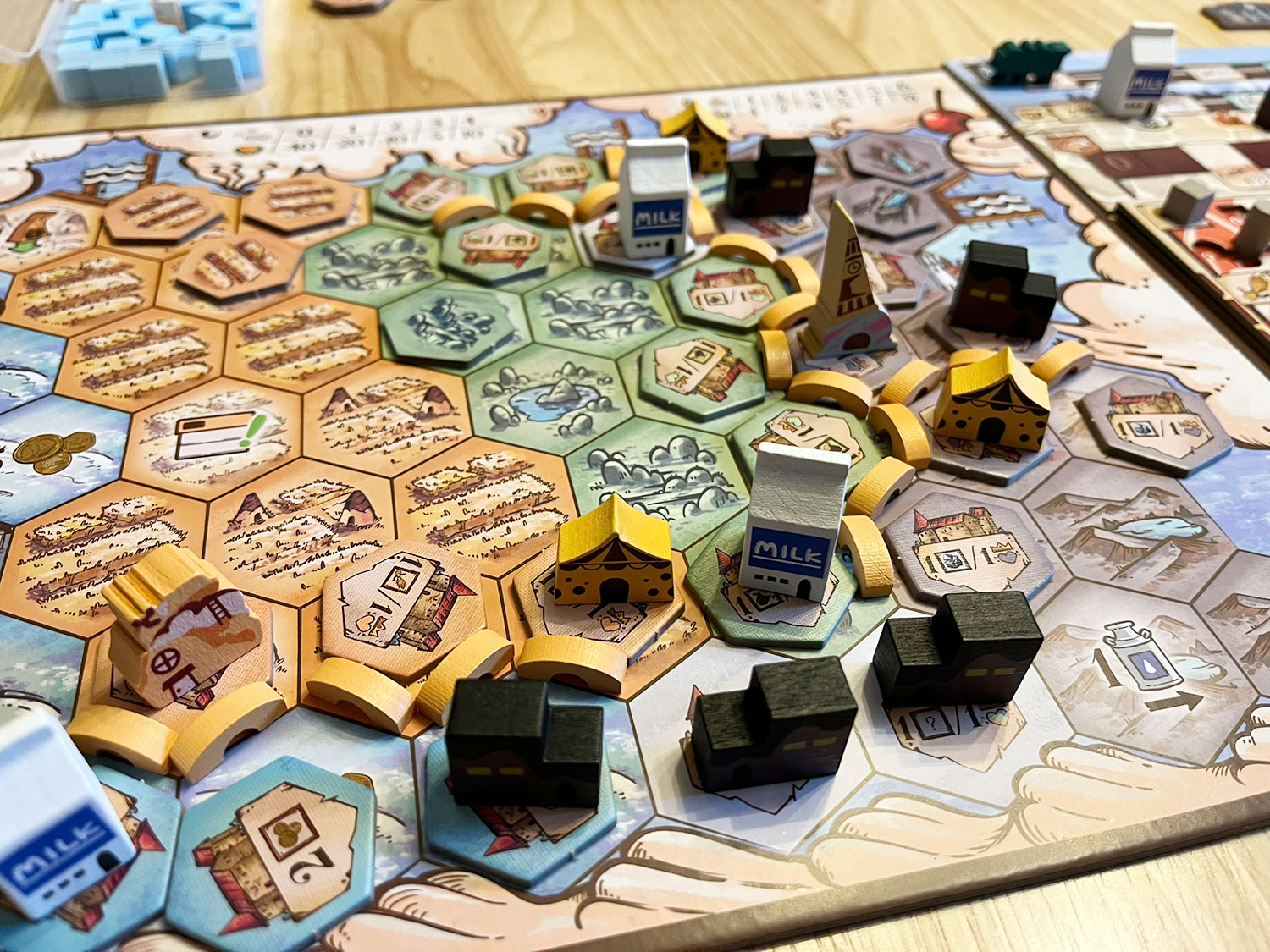 An example of an individual playerboard at end-game, filled with brownie buildings, cheese tents, and milk-research labs comprising a total of four unique cities.
An example of an individual playerboard at end-game, filled with brownie buildings, cheese tents, and milk-research labs comprising a total of four unique cities.Game Experience:
Do not be misled by the cutesy confectionery theme, pastel palette, and alliteratively alluring cards; Sweet Lands is a brutally tight, rules-intensive heavy Eurogame. It will likely take a few plays before you feel like you’re accomplishing more than the bare minimum, and at a solid 2 hours for a 2-player game, that’s a bit of commitment. My partner and I ended our first game with just 2 cities each in our respective confectionery countries, and only one of us broke 100 points (I won’t say who). By game three, we were both scoring in the mid-200s with 4 cities each, and at least based on the scoring tracks, it seems there’s still ample room for improvement.
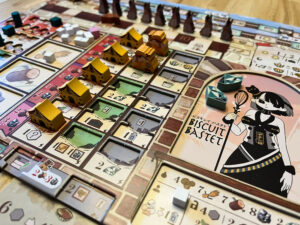 An individual dual-layer playerboard, shown at end-game. This player went all-in on brownie buildings (they’re gone), whereas only a few cream puff houses, and zero cheese tents were constructed.
An individual dual-layer playerboard, shown at end-game. This player went all-in on brownie buildings (they’re gone), whereas only a few cream puff houses, and zero cheese tents were constructed.This is the type of game where you cannot do everything. Much of the big scoring comes from the end of certain tracks, so you’ll want to specialize in certain areas and max them out. Specialization will largely be dictated by the character you play; there are 14 different options, each with unique and powerful capabilities that you’ll really want to lean into. The deck of 207 unique cards, 6 possible variants of personal map board layouts, and 5-7 various pairings of aid tiles to draft each round (among 25 total options) will dictate your options for executing various strategies. Altogether, these and several additional game elements combine for fairly decent replayability.
As for player interaction, there isn’t too much outside of the worker-placement element, a competition to achieve certain milestones and final-scoring tiles, and a draft for choosing aid-tile pairings each round. Considering the tightness of both resources and actions in the game, I’m okay with this limited interaction, as it might be frustrating in such a thinky puzzle with long-term planning to constantly have your plans foiled. The game does provide additional action spots for worker placement at higher player counts, but considering the already lengthy playtime and limited player interaction, I can’t really see the point of playing at four players, or possibly even three.
 Six of the game’s fourteen possible characters, each providing a unique, asymmetric player power.
Six of the game’s fourteen possible characters, each providing a unique, asymmetric player power.If I had to compare Sweet Lands to another game, Terra Mystica probably comes closest, owing to the difficulty, asymmetric powers, tightness of resources, multi-step constructing process on hexagonal maps, and drafting of tiles between rounds. But Sweet Lands is very much a different game; it is a far more attractive production, the individual maps significantly reduce player interaction (and also the meanness), and the card-play adds a major new element.
The card-play may be one of the more unique factors of Sweet Lands, as you’ll need to decide which card to play into your tableau and which you’re willing to discard for a worker-placement spot or in exchange for desperately needed resources. As players enter the second and third rounds of Sweet Lands, new, more powerful versions of existing worker-placement spots become available, although there is a higher resource cost for the improved action efficiency. Cards equate to actions, so discarding 3 cards to access a particular worker-placement spot could mean losing 2 turns; you’ll need to carefully consider if it’s worth taking that action now, waiting for the next round, or executing a different version of that action (possibly weaker or more resource-intensive).
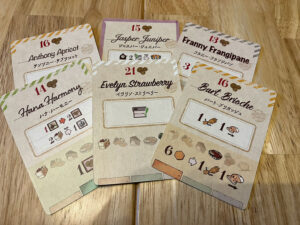 Each card features a different set of sweets tags, recipe names, and unique one-time and/or repeat abilities.
Each card features a different set of sweets tags, recipe names, and unique one-time and/or repeat abilities.The card variability among 207 options is both exciting and sometimes frustrating. Each card is classified into one, none, or all three industry types, which may matter for various player objectives. In addition to industry type, each card will have one or more types of 6 possible sweets tags. Finally, the cost to play cards varies from 4 to 26 coins, with rewards usually proportional to the cost. Early game, playing a 20+ coin card is likely prohibitively expensive. Many of the higher-cost cards also require specific sweet tags that players may or may not have (even by late game) to maximize their value. Thus, the value of the various cards is highly dependent on the round of the game as well as the state of play of the individual players. The rulebook suggests drafting opening hands as a variant, though I feel this should be standard practice after your first game. I would even recommend drafting your new 5 cards at the beginning of each subsequent round as well, since this helps minimize the luck factor across the huge deck in a game of limited overall card draw.
My only other nitpick is that the free actions (mostly resource conversions) are used constantly, and it would have been helpful to have these listed on a more visibly accessible player aid.
Final Thoughts:
Sweet Lands is a visually stunning production stuffed with adorable dessert-themed buildings and recipe-related alliterations throughout. The gameplay, however, is anything but cute. Players should be prepared for brutally tight resource management, hefty rules overhead, and approximately 60 minutes per player. For lovers of minimal-interaction heavy Eurogames, that may still be a sweet proposition, especially to experience an innovative card-play system, a thinky puzzle with multiple routes to victory, and strategies that will change depending on your asymmetric character and card-draw. The cards introduce some randomness, but this can be somewhat mitigated via drafting. In summary, Sweet Lands offers a sugary theme, a tiny pinch of spicy player interaction, and an overall very nice strategic puzzle.
Final Score: 4 Stars – Like its cookie rabbit pieces, it’s absolutely adorable, but also quite crunchy and may give you a headache from overindulgence if played at higher player counts
Disclaimer: DO NOT eat the components
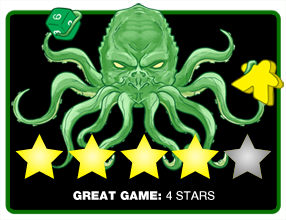 Hits:
Hits:
• Innovative card integration into game play
• Fabulous confectionery-themed production
• Asymmetric characters and maps enhance replayability
Misses:
• Cards introduce randomness; drafting recommended
• Excessive length at higher player counts
• Player aid for free actions would have been helpful




/pic8751380.png)
/pic199425.jpg)



/pic6792470.jpg)










 English (US) ·
English (US) ·  French (CA) ·
French (CA) ·